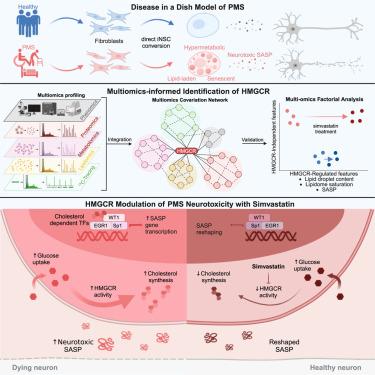当前位置:
X-MOL 学术
›
Cell Stem Cell
›
论文详情
Our official English website, www.x-mol.net, welcomes your
feedback! (Note: you will need to create a separate account there.)
Increased cholesterol synthesis drives neurotoxicity in patient stem cell-derived model of multiple sclerosis
Cell Stem Cell ( IF 19.8 ) Pub Date : 2024-10-21 , DOI: 10.1016/j.stem.2024.09.014 Rosana-Bristena Ionescu, Alexandra M. Nicaise, Julie A. Reisz, Eleanor C. Williams, Pranathi Prasad, Cory M. Willis, Madalena B.C. Simões-Abade, Linda Sbarro, Monika Dzieciatkowska, Daniel Stephenson, Marta Suarez Cubero, Sandra Rizzi, Liviu Pirvan, Luca Peruzzotti-Jametti, Valentina Fossati, Frank Edenhofer, Tommaso Leonardi, Christian Frezza, Irina Mohorianu, Angelo D’Alessandro, Stefano Pluchino
Cell Stem Cell ( IF 19.8 ) Pub Date : 2024-10-21 , DOI: 10.1016/j.stem.2024.09.014 Rosana-Bristena Ionescu, Alexandra M. Nicaise, Julie A. Reisz, Eleanor C. Williams, Pranathi Prasad, Cory M. Willis, Madalena B.C. Simões-Abade, Linda Sbarro, Monika Dzieciatkowska, Daniel Stephenson, Marta Suarez Cubero, Sandra Rizzi, Liviu Pirvan, Luca Peruzzotti-Jametti, Valentina Fossati, Frank Edenhofer, Tommaso Leonardi, Christian Frezza, Irina Mohorianu, Angelo D’Alessandro, Stefano Pluchino

|
Senescent neural progenitor cells have been identified in brain lesions of people with progressive multiple sclerosis (PMS). However, their role in disease pathobiology and contribution to the lesion environment remains unclear. By establishing directly induced neural stem/progenitor cell (iNSC) lines from PMS patient fibroblasts, we studied their senescent phenotype in vitro. Senescence was strongly associated with inflammatory signaling, hypermetabolism, and the senescence-associated secretory phenotype (SASP). PMS-derived iNSCs displayed increased glucose-dependent fatty acid and cholesterol synthesis, which resulted in the accumulation of lipid droplets. A 3-hydroxy-3-methylglutaryl (HMG)-coenzyme A (CoA) reductase (HMGCR)-mediated lipogenic state was found to induce a SASP in PMS iNSCs via cholesterol-dependent transcription factors. SASP from PMS iNSC lines induced neurotoxicity in mature neurons, and treatment with the HMGCR inhibitor simvastatin altered the PMS iNSC SASP, promoting cytoprotective qualities and reducing neurotoxicity. Our findings suggest a disease-associated, cholesterol-related, hypermetabolic phenotype of PMS iNSCs that leads to neurotoxic signaling and is rescuable pharmacologically.
中文翻译:

胆固醇合成增加导致多发性硬化症患者干细胞衍生模型的神经毒性
已在进行性多发性硬化症 (PMS) 患者的脑病变中发现衰老神经祖细胞。然而,它们在疾病病理学中的作用和对病变环境的贡献仍不清楚。通过从 PMS 患者成纤维细胞建立直接诱导的神经干细胞/祖细胞 (iNSC) 系,我们在体外研究了它们的衰老表型 。衰老与炎症信号传导、代谢亢进和衰老相关分泌表型 (SASP) 密切相关。PMS 衍生的 iNSCs 显示葡萄糖依赖性脂肪酸和胆固醇合成增加,从而导致脂滴积累。发现 3-羟基-3-甲基戊二酰 (HMG) -辅酶 A (CoA) 还原酶 (HMGCR) 介导的脂肪生成状态通过胆固醇依赖性转录因子在 PMS iNSCs 中诱导 SASP。来自 PMS iNSC 系的 SASP 诱导成熟神经元的神经毒性,HMGCR 抑制剂辛伐他汀治疗改变了 PMS iNSC SASP,促进细胞保护特性并降低神经毒性。我们的研究结果表明,PMS iNSCs 存在与疾病相关的、胆固醇相关的代谢亢进表型,可导致神经毒性信号传导,并且可以通过药理学治愈。
更新日期:2024-10-21
中文翻译:

胆固醇合成增加导致多发性硬化症患者干细胞衍生模型的神经毒性
已在进行性多发性硬化症 (PMS) 患者的脑病变中发现衰老神经祖细胞。然而,它们在疾病病理学中的作用和对病变环境的贡献仍不清楚。通过从 PMS 患者成纤维细胞建立直接诱导的神经干细胞/祖细胞 (iNSC) 系,我们在体外研究了它们的衰老表型 。衰老与炎症信号传导、代谢亢进和衰老相关分泌表型 (SASP) 密切相关。PMS 衍生的 iNSCs 显示葡萄糖依赖性脂肪酸和胆固醇合成增加,从而导致脂滴积累。发现 3-羟基-3-甲基戊二酰 (HMG) -辅酶 A (CoA) 还原酶 (HMGCR) 介导的脂肪生成状态通过胆固醇依赖性转录因子在 PMS iNSCs 中诱导 SASP。来自 PMS iNSC 系的 SASP 诱导成熟神经元的神经毒性,HMGCR 抑制剂辛伐他汀治疗改变了 PMS iNSC SASP,促进细胞保护特性并降低神经毒性。我们的研究结果表明,PMS iNSCs 存在与疾病相关的、胆固醇相关的代谢亢进表型,可导致神经毒性信号传导,并且可以通过药理学治愈。






























 京公网安备 11010802027423号
京公网安备 11010802027423号